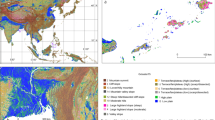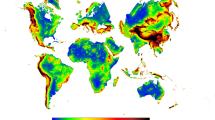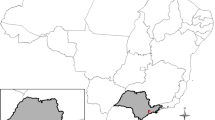Abstract
Estimation of the degree of local seismic wave amplification (site effects) requires precise information about the local site conditions. In many regions of the world, local geologic information is either sparse or is not readily available. Because of this, seismic hazard maps for countries such as Mozambique, Pakistan and Turkey are developed without consideration of site factors and, therefore, do not provide a complete assessment of future hazards. Where local geologic information is available, details on the traditional maps often lack the precision (better than 1:10,000 scale) or the level of information required for modern seismic microzonation requirements. We use high-resolution (1:50,000) satellite imagery and newly developed image analysis methods to begin addressing this problem. Our imagery, consisting of optical data and digital elevation models (DEMs), is recorded from the ASTER (Advanced Spaceborne Thermal Emission and Reflection Radiometer) sensor system. We apply a semi-automated, object-oriented, multi-resolution feature segmentation method to identify and extract local terrain features. Then we classify the terrain types into mountain, piedmont and basin units using geomorphometry (topographic slope) as our parameter. Next, on the basis of the site classification schemes from the Wills and Silva (1998) study and the Wills et al (2000) and Wills and Clahan (2006) maps of California, we assign the local terrain units with V s 30 (the average seismic shear-wave velocity through the upper 30m of the subsurface) ranges for selected regions in Mozambique, Pakistan and Turkey. We find that the applicability of our site class assignments in each region is a good first-approximation for quantifying local site conditions and that additional work, such as the verification of the terrain’s compositional rigidity, is needed.
Similar content being viewed by others
References
Abrams M 2000 The advanced spaceborne thermal emission and reflectance radiometer (ASTER): Data products for the high spatial resolution imager on NASA’s Terra platform; Int. J. Remote Sens. 21 847–859.
Abrams M and Hook S J 1995 Simulated Aster data for geologic studies; IEEE Trans. Geosci. Remote Sens. 33 692–699.
Abrams M, Hook S and Ramachandran B 2002 ASTER User Handbook, Jet Propulsion Laboratory/California Institute of Technology, Pasadena, 135 pp.
Anderson J G, Lee Y, Zeng Y and Day S 1996 Control of strong motion by the upper 30 meters; Bull. Seismol. Soc. Am. 86 1749–1759.
Bard P Y and Bouchon M 1980 The seismic response of sediment-filled valleys. Part 1. The case of incident SH waves; Bull. Seismol. Soc. Am. 70 1263–1286.
Bard P Y and Gabriel J C 1986 The seismic response of two-dimensional sedimentary deposits with large vertical velocity gradients; Bull. Seismol. Soc. Am. 76 343–346.
Bard P Y and Tucker B E 1985 Underground and ridge site effects: A comparison of observation and theory; Bull. Seismol. Soc. Am. 75 905–922.
Bolongaro-Crevenna A, Torres-Rodríguez V, Sorani V, Frame D and Ortiz M A 2005 Geomorphometric analysis for characterizing landforms in Morelos State, Mexico; Geomorphology 67 407–422.
Boore D M and Joyner W B 1997 Site amplification for generic rock sites; Bull. Seismol. Soc. Am. 87 327–341.
Borcherdt R D 1970 Effects of local geology on ground motion near San Francisco Bay; Bull. Seismol. Soc. Am. 60 29–61.
Borcherdt R D 1994 Estimates of site-dependent response spectra for design (methodology and justification); Earthquake Spectra 10 617–653.
Clark P J and Evans F C 1954 Distance to nearest neighbor as a measure of spatial relations in populations; Ecol. 35 445–453.
Definiens 2006 Definiens Professional 5 Basic Training Material; Definiens AG, Munchen, 69 pp.
Dehn M, Gartner H and Dikau R 1999 Principles of semantic modeling of landform structures, 4th International Conference on GeoComputation 1999, July 25–28: Fredericksburg, Virginia.
Dikau R, Brabb E E and Mark R M 1991 Landform classification of New Mexico by computer; U.S. Geol. Surv. Open-File Rept. 634 15 pp.
Farr T G, Rosen P A, Caro E, Crippen R, Duren R, Hensley S, Kobrick M, Paller M, Rodriquez E, Roth L, Seal D, Shaffer S, Shimada J, Werner M, Oskin M, Burbank D and Alsdorf D 2007 The shuttle radar topography mission; Jet Propulsion Laboratory/California Institute of Technology, Pasadena, 43 pp.
Hammond E H 1964 Classes of land surface form in the forty-eight states, U.S.A.; scale 1:5,000,000.
Hirano A, Welch R and Lang H 2003 Mapping from ASTER stereo image data: DEM validation and accuracy assessment; Photogramm. Remote Sens. 57 356–370.
I.C.B.O. (International Conference of Building Officials) 1997 Uniform Building Code, International Conference of Building Officials, Whittier, 1411 pp.
Kääb A, Huggel C, Paul F, Wessels R, Raup B, Kieffer H and Kargel J 2002 Glacier monitoring from ASTER imagery: accuracy and applications; In: Proceedings of EARSeL-LISSIG-Workshop Observing our Cryosphere from Space, March 11–13, Bern, Switzerland.
Kurtz R, Kline K and Lacasse J 2006 Preliminary review of the new Landsat 7 segment-based gap-fill; In: Proc. Thirteenth Australasian Remote Sensing and Photogrammetry Conference, November 20–24, Canberra, Australia.
Munir M and Butt A A 2007 The paleogene of Azad Kashmir, Hazara Kashmir syntaxis, Pakistan; In: Proc. Geophysical Research Abstracts of 2007 European Geosciences Union, Volume 9-11052, April 15–20, Vienna, Austria.
Navulur K 2006 Multispectral image analysis using the object-oriented paradigm, CRC Press, Boca Raton, 165 pp.
Nawaz F, Hamidullah F and Fayaz A 2004 The effect of mining on geomorphology; detection of changes by using remote sensing techniques; In: Proceedings of the ISRPS 2004 Annual Conference, July 19–23, Istanbul, Turkey.
Park S and Elrick S 1998 Predictions of shear-wave velocities in southern California using surface geology; Bull. Seismol. Soc. Am. 88 677–685.
Pike R J 2002 A bibliography of terrain modeling (geomorphometry), the quantitative representation of topography; Supplement 4.0; U.S. Geol. Surv. Open-File Rept. 465 158 pp.
Romero S M and Rix G J 2001 Ground motion amplification of soils in the upper Mississippi embayment, Report No. GIT-CEE/GEO-01-1, 461 pp.
Sánchez-Sesma F J and Campillo M 1993 Topographic effects for incident P, SV and Rayleigh waves; Tectonophys. 218 113–125.
Tinsley J, Hough S E, Yong A, Kanamori H, Yu E, Appel V and Wills C J 2004 Geotechnical Characterization of TriNet Sites: A Status Report; Seismol. Res. Lett. 75 505.
Wald D J and Allen T I 2007 Topographic slope as a proxy for seismic site conditions and amplification; Bull. Seismol. Soc. Am. 97 1379–1395.
Wald D J, Wald L, Worden B and Goltz J 2003 ShakeMap — a tool for earthquake response; U.S. Geol. Surv. Fact Sht. 87 4 pp.
Williams V S, Pasha M K and Sheikh I M 1999 Geologic map of the Islamabad—Rawalpindi area, Punjab, northern Pakistan (map supplement); U.S. Geol. Surv. Open-File Rept. 47 16 pp.
Wills C J and Clahan K B 2006 Developing a map of geological defined site-condition categories for California; Bull. Seismol. Soc. Am. 96 1483–1501.
Wills C J, Petersen M, Bryant W A, Reichle M, Saucedo G J, Tan S, Taylor G and Treiman J 2000 A site-conditions map for the California based on geology and shear-wave velocity; Bull. Seismol. Soc. Am. 90 S187–S208.
Wills C J, Silva M and Yong A 2007 Progress toward more detailed site-conditions maps in southern California; In: Proc. SCEC 2006 Annual Meeting, September 8–12, Palm Springs.
Wills C J and Silva W 1998 Shear-wave velocity characteristics of geologic units in California; Earthquake Spectra 14 533–556.
Yamaguchi Y, Kahle A B, Tsu H, Kawakami T and Pniel M 1998 Overview of advanced spaceborne thermal emission and reflection radiometer (ASTER); IEEE Trans. Geosci. Remote Sens. 36 1062–1071.
Yong A, Hough S E, Hudnut K, Healy S, Giberson J and Simila G 2005 Geotechnical site characterization using remote sensing data: A feasibility study; In: Proc. SSA 2005 Annual Meeting, Lake Tahoe, NV.
Yong A, Hough S E, Wills C J and Abrams M 2006a A report on the geotechnical site characterization efforts in southern California; In: Proc. SCEC 2006 Annual Meeting, September 9–14, Palm Springs.
Yong A, Hough S E, Cox H, Tiampo K, Braverman A, Harvey J, Hook S, Hudnut K and Simila G 2006b Balloons to satellites: a century of progress in geotechnical site characterization; In: Proc. SSA 2006 Annual Meeting, San Francisco, CA.
Yong A, Hough S E, Wills C J and Abrams M J 2006c Site Characterization Using Satellite Imagery; In: Proc. AGU 2006 Fall Meeting, December 11–15 San Francisco, CA.
Yong A, Hough S E, Abrams M J, Cox H M, Wills C J and Simila G W 2008 Quantification of site characterization using integrated imaging analysis methods on satellite data of the Islamabad, Pakistan region Bull. Seismol. Soc. Am. 98(6) (in press)
Author information
Authors and Affiliations
Corresponding author
Rights and permissions
About this article
Cite this article
Yong, A., Hough, S.E., Abrams, M.J. et al. Preliminary results for a semi-automated quantification of site effects using geomorphometry and ASTER satellite data for Mozambique, Pakistan and Turkey. J Earth Syst Sci 117 (Suppl 2), 797–808 (2008). https://doi.org/10.1007/s12040-008-0061-7
Received:
Revised:
Accepted:
Published:
Issue Date:
DOI: https://doi.org/10.1007/s12040-008-0061-7




